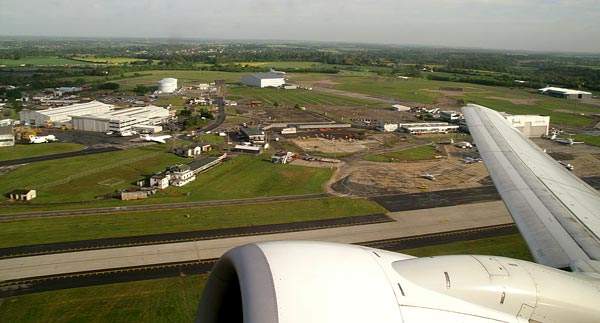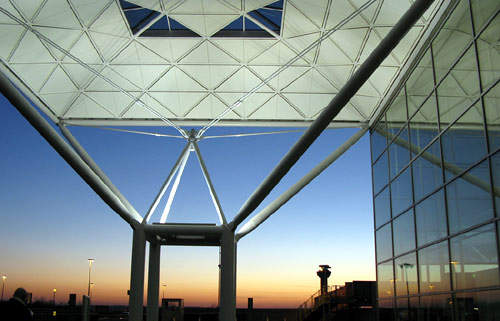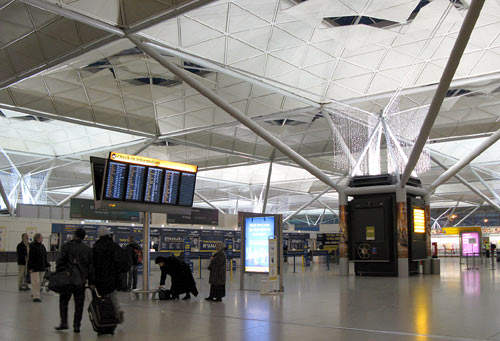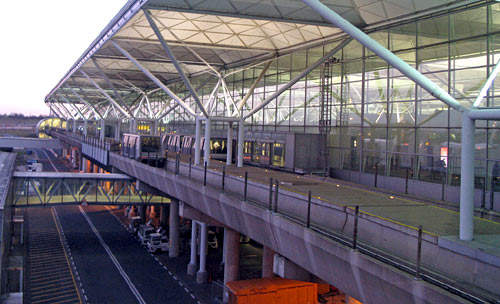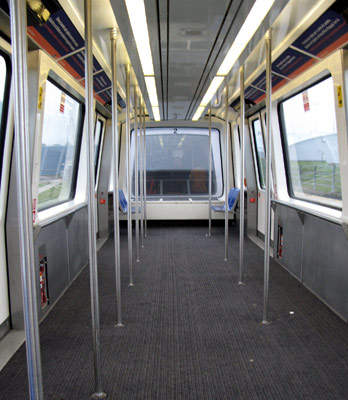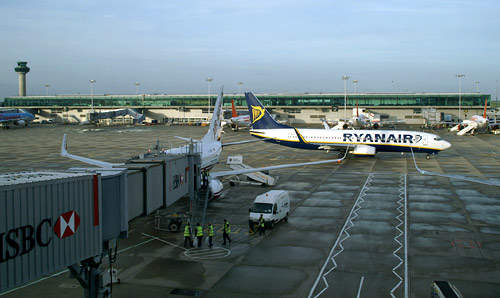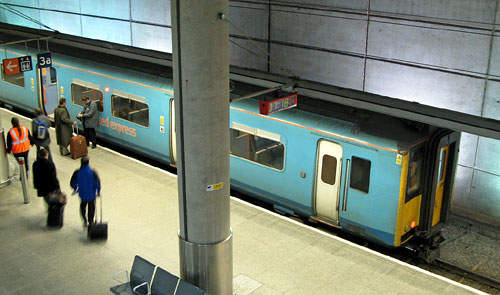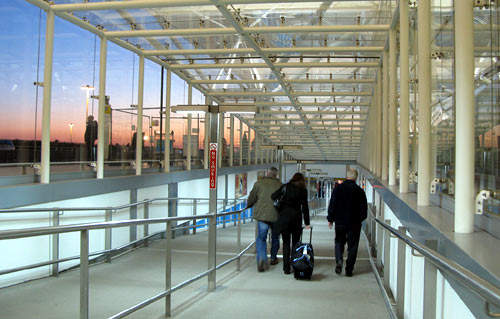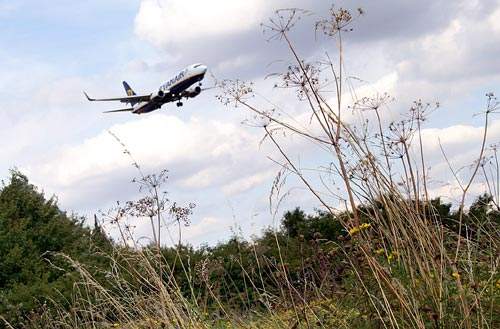Evolving from an airfield developed as a World War II US bomber base, Stansted Airport takes its name from nearby Stansted Mountfitchet in Essex. Stansted is 35 miles from Central London and the nearest town is Bishops Stortford, Hertfordshire.
After years of small-scale operation for maintenance, freight and in the emerging holiday charter market, the state-owned British Airports Authority took over in the mid 1960s, opening a new passenger terminal on the north side of the runway.
The modern Stansted era began with the process to designate a third London airport (after Heathrow and Gatwick) in 1984.
This led to new development largely on the site’s south side on the wedge of land between the runway alignment and that of the original A120 road route.
Although increasingly developed at the south and west end due to the airport, the M11 London-Cambridge motorway opening in stages, 1975-1980, and re-siting the upgraded A120, the airport’s setting remains largely rural to the north and east.
In 2012 (year ending March 2013), the airport handled 17.5 million passengers and witnessed 131,365 aircraft movements. It also handled 214,000t of cargo from January to December 2012.
The airport was owned and operated by LHR Airports Limited (formerly BAA Airports Limited) until 2013. In March 2009 the UK’s Competition Commission ordered BAA to sell off three of its seven airports, including Stansted. BAA mounted several legal challenges to this decision, but in July 2012 it was upheld in the Court of Appeal.
In August 2012, BAA agreed to sell Stansted airport. The airport attracted many bidders and the first round was completed in October 2011, with three companies shortlisted: Malaysia Airports Holdings, Macquarie of Australia and Manchester Airports Group (MAG) with its Australian partner Industry Funds Management (IFM). In January 2013, each company submitted its bid for the airport.
On 18 January 2013 MAG announced that it had purchased Stansted Airport for £1.5bn ($2.4bn). As part of the transaction, IFM will take a 35.5% stake in MAG in return for company and new equity investment. MAG also owns Manchester, East Midlands and Bournemouth airports.
Stansted Airport infrastructure
Stansted’s high traffic levels are accommodated on a single 3,048m runway (05/23). It is one of seven UK airports owned by BAA, the company resulting from the privatisation of the British Airports Authority in 1987. BAA was bought by Spanish construction group Ferrovial in 2006, also owner of ground handler Swissport, which has a large Stansted presence. The airport is the third busiest in the UK and hosts 33 airlines serving over 165 destinations in 35 countries.
The single passenger terminal opened in 1991, an award-winning design by Foster Associates. Allowing for relatively easy redeployment of internal space, the high-roofed structure, which is a floating roof supported by a custom designed space frame of inverted roof trusses makes use of indirect lighting and natural light for a calming effect.
Main passenger flows are all on one level, that of the approach road, and unusually for a UK airport, Stansted incorporated a mainline railway station from the outset. With expansion in the same style, the terminal functioned well for many years, but increasing numbers coupled with higher-level security and passport checks have caused serious delays.
Aircraft gates are at three piers, in part accessed by a high-capacity automatic AEG Westinghouse people mover that completes a circuit from the terminal building. One pier is entirely served by a walkway connection. Air bridges are also widely fitted, although the dominant low cost airline users do not use that facility.
Airport operations
Although not a consideration in the 1980s airport’s expansion, Stansted has become primarily a base for low-cost airlines, with main operators Ryanair and Easyjet (which took over locally based Go, the BA subsidiary) accounting for around 80% of aircraft movements.
Charter operations are relatively small, and long-haul routes have had mixed fortunes, as have the single-class, low-density transatlantic flights using Stansted. Most common aircraft types are from the Boeing 737 and Airbus A320 families.
Stansted is the second-largest UK freight airport, its figures heavily weighted to loadings by dedicated operators such as FedEx, UPS and TNT, as opposed to belly-hold on passenger flights.
The airport site contains long, medium and short-stay parking, the latter within walking distance of the terminal. Around 40% of airport passengers use public transport for access, made up of local and long distance buses, and train services using the airport rail spur from a triangular junction on the Cambridge-London main line. Mainly on a 15-minute interval, Stansted Express trains take 45 minutes from London Liverpool Street station.
Expansion plans
Begun in April 2007, a £50m expansion added 5,900m² of floor space to the terminal’s international arrivals area. It included extra baggage carousels, doubling the size of the immigration hall, passport control and providing improved ‘meet and greet’ facilities. The works were started in June 2008 and were completed in December 2008. The main management and construction contractor for the project was Mace and the design architect was Pascall & Watson. The terminal extension measures 36m×162m and has involved the erection of 22 diagrids for the hypostyle roof along with six support trees.
Stansted figured prominently in The Future of Air Transport white paper of December 2003, where support was given for a second runway. BAA made an application in March 2008 for the second runway. In May 2010, however, the plan for the second runway was withdrawn.
Expansion took extra land to the west (requirements for land have now been reduced from 700 acres to around 442 acres). In addition the number of residential buildings required to be demolished was reduced by 25% and ten listed buildings were relocated.
BAA applied to the Uttlesford District Council in April 2006 to remove the passenger limit (currently 25 million a year) and increase the number of flights by 75,000 a year (currently 264,000). So far this has not been allowed.
The 2003 white paper ruled out the two or three extra Stansted runways suggested previously that indicated taking the mantle of principle London airport from Heathrow, also BAA-owned.
As well as battling a well-organised anti-expansion organisation that focuses upon environmental impact, resistance to higher payments by airlines, in 2006 the local authority rejected passengers numbers going beyond the prevailing 25 million a year limit.
A downturn in passenger levels in late 2007 ascribed to cutbacks by low-cost airlines also proved damaging to the expansion case.
Passenger terminal redevelopment at London Stansted Airport
The airport authorities started an £80m terminal redevelopment project in June 2013. The redevelopment is expected to improve the passenger services.
The project includes construction of new security facilities, a departure longue, increasing the seating capacity, improving the concessions and deployment of enhanced way-finding and extra flight information screens.
The project will receive £40m funding from Manchester Airports. The remaining £40m will be funded by the airport’s commercial partners.
Second runway
BAA made an application in March 2008 for the intended second runway (the expansion project was known as the Stansted Generation 2 project (G2), for which separate planning applications were made. This became the subject of a public inquiry which began on 15th April 2009.
In July 2008 the Secretary of the Department of Transport called in the G2 project, meaning the projects involved would proceed to a planning decision from central government following an inquiry. After the UK general elections in 2010, the G2 planning application was withdrawn by the newly formed government.
Parking facilities
The airport’s parking facility provides 25,726 spaces. The parking options offered are long stay, short stay and valet parking. Long stay parking is available throughout the year. Mid-stay parking is nearer to the terminal than the long stay and also acts as an alternative to long and short stay parking.
Air traffic control tower
The control tower of the airport, which is regarded as one of the highest towers in the UK, was opened in 1991. The tower lies to the south of the terminal building. The current tower has replaced old tower of Stansted.

